This topic takes on average 55 minutes to read.
There are a number of interactive features in this resource:
 Chemistry
Chemistry
 Science
Science
The first stage of making a medicine is to manufacture the active ingredient.We call this stage the primary manufacture.The active pharmaceutical ingredient (API) will normally make up a small proportion of the final medicine. However this is the part that will treat the disease.
There are two main ways of developing the active ingredient
Developing the process to manufacture the active ingredient requires skilled chemists and chemical engineers to investigate alternative chemical reactions to find out which makes the product they want in the highest yield and purity. They also have to consider the environment. So the solvents used will, wherever possible, be water based and energy consumption will be minimised. During research and development the chemical rections will have been scaled up in a pilot plant similar to the one shown in the virtual tour below.
The six basic stages in manufacture are:
Inputs 1 delivery of ingredients to the factory
2 checking that the ingredients meet the required specification
Processes
3 mixing and granules
4 drying
5 pressing
6 coating.
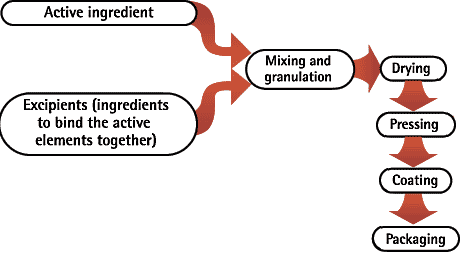
The powdered ingredients are placed inside a mixer like a large food mixer. They are mixed to ensure that the active ingredients are combined uniformly with the excipients. Unless this process happens thoroughly, one tablet may have too much activity and another none at all. Water is then added to granulate the mixture. The water binds the powders together to form granules (like instant coffee). This stops the powders from separating (or demixing) whenever the mixture is moved.
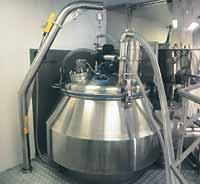
The granules are dried in a fluid bed drier. This has a large fan facing upwards. It creates giant currents of heated air. The air picks up the granules and carries them up in a warm flow. The granules fall down and are picked up by more hot air.
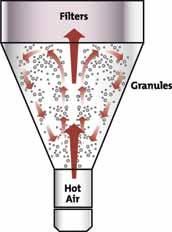
The granules pass from the fluid bed drier through a sieve. This breaks up the oversized granules and ensures the size is uniform. The powder of fine granules is then ready to be pressed into tablets.
The tablet press is a high-speed mechanical device. It 'squeezes' the ingredients into the required tablet shape with extreme precision. It can make the tablet in many shapes, although they are usually round or oval. Also, it can press the name of the manufacturer or the product into the top of the tablet.
Each tablet is made by pressing the granules inside a die made of hardened steel. The die is a disc shape with a hole cut through its centre. The powder is compressed in the centre of the die by two hardened steel punches that fit into the top and bottom of the die.
The punches and dies are fixed to a turret that spins round. As it spins, the punches are driven together by two fixed cams - an upper and lower cam. The shapes of the two cams determine the sequence of movements of the two punches. This sequence is repeated over and over because the turret is spinning round.
The force exerted on the ingredients in the dies is very carefully controlled. This ensures that each tablet is perfectly formed. The turret holds up to 75 dies and pairs of punches. It spins extremely fast and can produce up to 600, 000 tablets per hour.
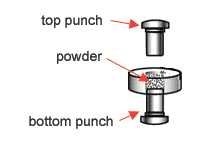
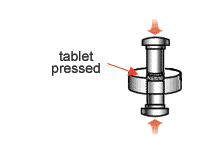
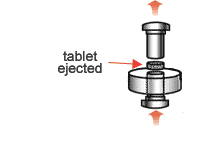
Samples of tablets from the press are checked regularly, whilst the machine is running to ensure that:
Some tablets are then coated. The coating performs a number of jobs. For example it can be to